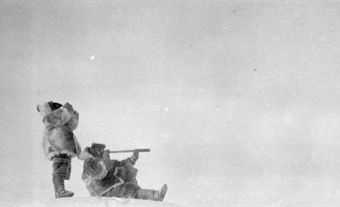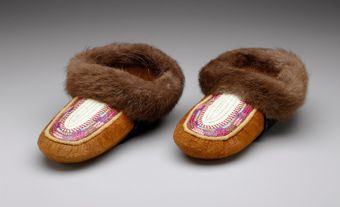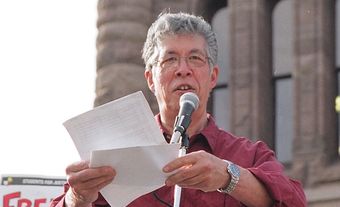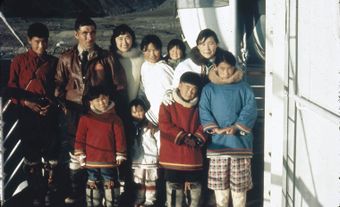
Early life
Markoosie Patsauq was a young child when his family moved into the settlement in Inukjuak, Quebec. Inuit were under political and other pressure to leave their traditional seminomadic life behind and participate more fully in the market economy. The “Eskimo Identification System” was inaugurated around that same time. The federal government issued each Inuk a disk to wear around their neck, marked with either E or W (for Eastern or Western Arctic), followed by numbers indicating their region as well as their personal identifier; Patsauq’s own identification number was E9-725. Later, in 1970, Inuit (who traditionally used only one name) were forced to adopt family names, and his family became known as Patsauq. (See also Project Surname.) The name Markoosie is an Inuktitut-sounding version of a Christian name, which was a common way Inuit adapted their names. This method dates from contact with European whalers but especially evangelization by Anglican and Catholic missionaries in the late 19th to early 20th centuries. (See also Missions and Missionaries.)
In July 1953, Patsauq and his family were forcibly moved 1,943 km north to Resolute Bay, called Qausuittuq, “which never has daylight,” by Inuit. (See also Inuit High Arctic Relocations in Canada.) Officially, Inuit were moved to seek better hunting. In reality, relocations were meant to reinforce Canada’s claim to sovereignty in the Arctic. (See also Canadian Arctic Sovereignty.) Although the authorities promised the Inuit they could return in two years, most had to stay in the Far North for decades. Along with his parents, siblings and several other families, 12-year-old Patsauq was loaded onto a ship for the two-month trip, even though he was suffering from tuberculosis (TB). The mid-20th century TB epidemic resulted in thousands of Inuit (including infants) being taken from their families and sent south for treatment. Following that first winter in Resolute, when they sheltered in a canvas tent on the beach, the severely ill Patsauq was sent alone to the Clearwater Lake Sanatorium in Manitoba, where he would spend two years. (See also Indian Hospitals in Canada.) Once recovered, Patsauq returned to Resolute but then went to residential school in Yellowknife for eight months. (See also Inuit Experiences at Residential School.)
Career Highlights
While still a student, Patsauq worked for Atlas Aviation in Resolute. He eventually went to Goderich, Ontario, for training and became the first Inuk in Canada to obtain a commercial pilot’s license. He flew the Eastern Arctic for over a decade, primarily for mining companies.
During the times that his airplane was grounded by bad weather in the Far North, Patsauq took the opportunity to write. In the mid-1960s, he took fragments of a story he had been told by family members during his childhood about a young hunter’s dramatic encounter with a polar bear, and the 23-year-old pilot crafted the various threads into a short novel. He sent his 73-page manuscript, written in Inuit syllabics and titled ᐆᒪᔪᕐᓯᐅᑎᒃ ᐅᓈᑐᐃᓐᓇᒧᑦ (Uumajursiutik unaatuinnamut), off to the only publication venue known to him, Inuktitut Magazine. The long story was immediately printed in his mother tongue in three installments. James H. McNeill, a children’s literature author put in charge of that magazine as a federal employee of what was at the time known as the Department of Indian and Northern Affairs, urged the bilingual author to produce an English version. The heavily edited result was published under the title Harpoon of the Hunter and became a bestseller. That book was subsequently translated into several languages, including Danish, Estonian and French. The first French rendition was done by noted novelist and Governor General’s Award winner Claire Martin in 1971. All translations had been based on the first English adaptation, and for 50 years no one conducted any investigation into either Patsauq’s original Inuktitut text or the complex circumstances surrounding its publication.
In 2021, brand-new translations, done rigorously from Patsauq’s handwritten manuscript and with his collaboration, were released in English and French. These were accompanied by the Inuktitut original (in two scripts — syllabics as well as Romanized — making it more accessible to a broader range of Inuit readers. The new translations also included in-depth analysis and contextualization. This finally gave Patsauq’s groundbreaking work of literature its critical due. The trilingual volume Uumajursiutik unaatuinnamut / Hunter with Harpoon / Chasseur au harpon features a lengthy introduction by the author, recorded in 2017. Patsauq is considered the first Inuk and the first Indigenous person in Canada to publish a novel. Patsauq’s novel has been described by contemporary Cherokee author Thomas King as the inaugural work of Indigenous literature in Canada.
Although Patsauq went on to write a second novella (Wings of Mercy) and a number of short stories, his later life focused on raising his family and then on community activism.
Activism
In 1975, Patsauq was finally able to return to Inukjuak to live. Alongside Martha Flaherty and other prominent Inuit, he advocated for compensation for those families affected by the relocations. Markoosie appeared before a Royal Commission chaired by Mary Simon in the early 1990s. (In 2020, Simon also penned a foreword for the English translation of Markoosie’s novel; she became Canada’s governor general in 2021.) The government of Canada finally made an official apology in 2010. Patsauq’s brother, John Amagoalik (born in 1947), himself a writer and community leader, was also active in obtaining that apology, as well as in the founding of Canada’s most recent territory of Nunavut.
Death and Legacy
Patsauq died on 8 March 2020 of throat cancer at the age of 77. He left behind a large family: his second wife Annie; a son and four daughters from his first marriage to Zipporah; stepsons, grandchildren; and great-grandchildren. An obituary celebrating his life appeared in the national press. He is remembered for his literary and other accomplishments as well as for his resilience in the face of colonization and for his efforts to protect and promote Inuit culture.

 Share on Facebook
Share on Facebook Share on X
Share on X Share by Email
Share by Email Share on Google Classroom
Share on Google Classroom





.jpg)



